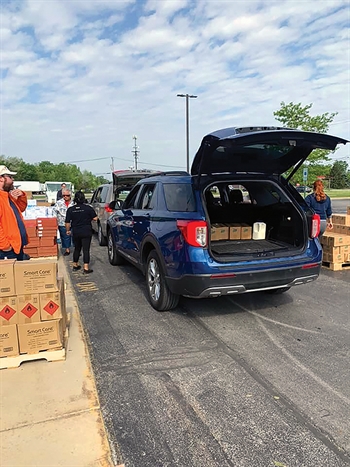December 2022 | Volume XL, Issue 4 »
Public Libraries in Illinois Initiating Food Justice
December 1, 2022
Miriam Rosen, Ph.D., Evanston Township High School
Hunger was a problem many families experienced in 2020 in addition to the many stresses of the COVID-19 pandemic. According to the United States Department of Agriculture (USDA), households dealing with food insecurity in Illinois increased to 38.3 million people in 2020 (Economic Research Service 2022). Food insecurity refers to the lack of access to, or inability to afford, healthy food. Although federally funded programs exist to help those in need, Illinois public library staff also play a part. Some public libraries have used the Summer Food Service Program (SFSP), a USDA program, to serve meals to hungry patrons. Food drives, like Food for Fines, are another way libraries can support local food pantries helping to address food insecurity.
Public libraries can implement food justice by providing summer meals and holding canned food drives. The food justice movement asserts that the current food system is interconnected with race and class in our society and low-income and communities of color are most severely impacted. Food justice is addressed by creating local systems to provide needed food (Alkon and Agyeman 2011, 4). In June of 2021 the author conducted research to better understand what public libraries in Illinois were doing to address food insecurity during the early months of the COVID-19 pandemic, with a focus on the food justice movement. There were 491 public library staff in Illinois who responded to an anonymous survey. The survey revealed two types of food programs being used in Illinois libraries: cooperative food programs and individual organic food programs.
PUBLIC LIBRARIES AND FOOD PROGRAMS
Cooperative food programs involve other groups or organizations, but still take place at the public library. Meals distributed at the library were the main cooperative food program reported by survey respondents. During the survey period of June and July 2021, 20% of respondents had a meal program at their library. Food drives and collecting canned goods was the other cooperative program mentioned in the survey. Food was later donated to local food pantries.

In a partnership with the Southland Voice and the Illinois Partners in Hope that began in February 2020, the Glenwood-Lynwood Public Library District distributes food and other household items. The library serves approximately 150 cars weekly.
According to the survey, 35% of respondents had individual organic food programs at their public libraries. The term “organic” refers to programs created by library staff, not to the way in which the food was grown and processed. The most common program was the mini food pantry, also referred to as micro pantries, little free food pantries, mini food banks, little free cupboards, cupboards, food boxes, food shelves, or gratis tables. These mini food pantries were initiated by library staff and included tables, bins, or cabinets of canned, fresh, frozen, or cold produce and food that patrons could give and/or take. Small onsite food pantries were usually described as being near the library entrance. Survey respondents noted that during the COVID-19 lock-down they often moved the pantry to a more accessible location outside of the building.
Other initiatives taken by public library staff were gardens (including seed banks and community gardens), cooking (including take & bake and kits), snacks (including prepackaged snacks and peanut butter and jelly sandwich bagged lunches), bags of groceries, gift cards or vouchers, monetary donations to food pantries, food baskets (holiday specific), blessing bags or community backpacks, and food pop-ups. During COVID-19, some libraries even had delivery or drive thru pickup for grocery bags, food baskets, and cooking kits.
SERVING COMMUNITY NEEDS
Data from the study suggests an emerging sense of social justice, specifically food justice activities, in public libraries in Illinois. Other programs and assistance, aside from providing physical food, were also being created by public library staff. Food stamp assistance programs were designed to help patrons apply for food stamps and learn how to use food stamps efficiently to buy and make healthy meals. This program was especially helpful if language or technology was a barrier for patrons. Another program focus was the use of guest speakers, such as dieticians and nurses, to provide diet and health information.
FINAL THOUGHTS
Public library staff can play a key role in helping to address the growing food insecurity problem in Illinois communities. Libraries can promote partnerships with local food banks and service organizations and/or create activities or programs specific to community needs. Public libraries provide the people in their community with more than a building. Libraries connect community members with important resources and services every day. They can even assist communities with fundamental human needs such as food.
REFERENCES
Alkon, Alison Hope, and Julian Agyeman, eds. 2011. Cultivating Food Justice: Race, Class, and Sustainability. MIT Press.
Economic Research Service. United States Department of Agriculture. 2022. “Food Security in the U.S.: Key Statistics and Graphics.” Economic Research Service. Last updated April 22, 2022. https://www.ers.usda.gov/topics/food-nutrition-assistance/food-security-in-the-u-s/key-statistics-graphics/.

 iREAD Summer Reading Programs
iREAD Summer Reading Programs Latest Library JobLine Listings
Latest Library JobLine Listings